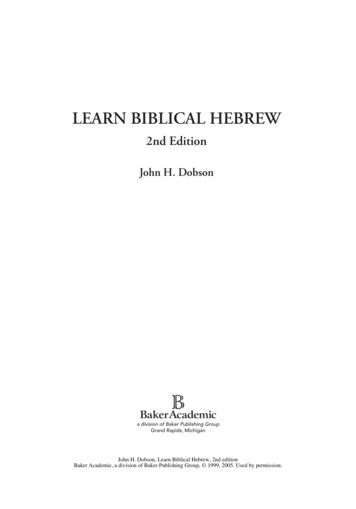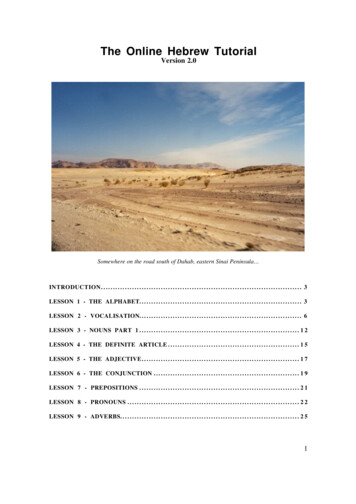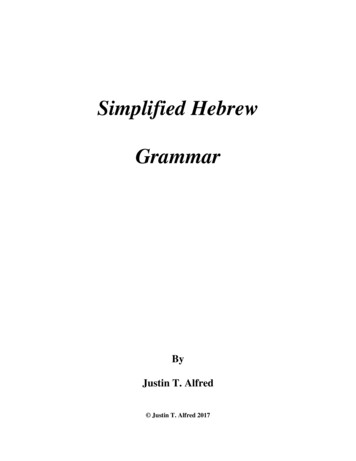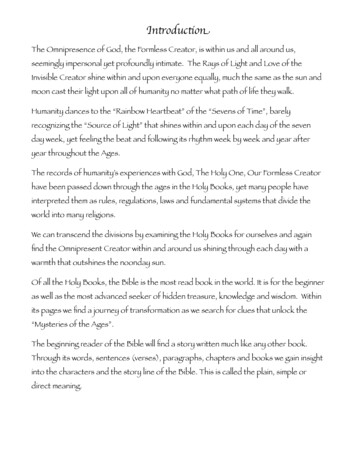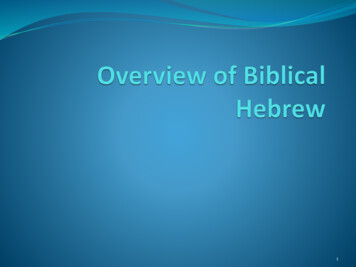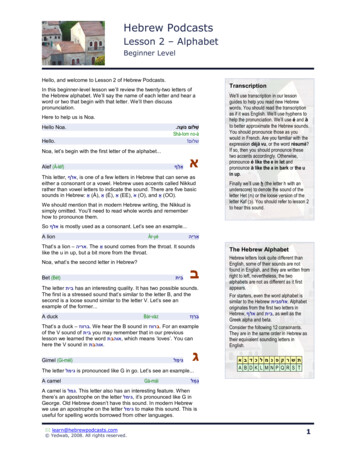
Transcription
Hebrew PodcastsLesson 2 – AlphabetBeginner LevelHello, and welcome to Lesson 2 of Hebrew Podcasts.In this beginner-level lesson we’ll review the twenty-two letters ofthe Hebrew alphabet. We’ll say the name of each letter and hear aword or two that begin with that letter. We’ll then discusspronunciation.Here to help us is Noa. ׁשלֹום נֹועָ ה ָShà-lom no-à! שלום Hello Noa.Hello.Noa, let’s begin with the first letter of the alphabet. ָאלֶ ף Alef (À-léf) א This letter, אלף , is one of a few letters in Hebrew that can serve aseither a consonant or a vowel. Hebrew uses accents called Nikkudrather than vowel letters to indicate the sound. There are five basicsounds in Hebrew: ַ ( א À), ֵ ( א É), ִ ( א EE), ֹ ( א O), and ֻ ( א OO).We should mention that in modern Hebrew writing, the Nikkud issimply omitted. You’ll need to read whole words and rememberhow to pronounce them.TranscriptionWe’ll use transcription in our lessonguides to help you read new Hebrewwords. You should read the transcriptionas if it was English. We’ll use hyphens tohelp the pronunciation. We’ll use é and àto better approximate the Hebrew sounds.You should pronounce those as youwould in French. Are you familiar with theexpression déjà vu, or the word résumé?If so, then you should pronounce thesetwo accents accordingly. Otherwise,pronounce é like the e in let andpronounce à like the a in bark or the uin up.Finally we’ll use h (the letter h with anunderscore) to denote the sound of theletter Het ( )ח or the loose version of theletter Kaf ( )כ . You should refer to lesson 2to hear this sound.So אלף is mostly used as a consonant. Let’s see an example.A lion ַארי ֵה ְÀr-yéThat’s a lion – אריה . The ַ א sound comes from the throat. It soundslike the u in up, but a bit more from the throat.Noa, what’s the second letter in Hebrew? ּבֵית Bet (Bét) ב The letter בית has an interesting quality. It has two possible sounds.The first is a stressed sound that’s similar to the letter B, and thesecond is a loose sound similar to the letter V. Let’s see anexample of the former.A duck ּב ְַרוָז Bàr-vàzThat’s a duck – ברווז . We hear the B sound in ברווז . For an exampleof the V sound of בית you may remember that in our previouslesson we learned the word אוהבת , which means ‘loves’. You canhere the V sound in אוהבת . ּגִימֶ ל Gimel (Gi-mél) ג The letter גימל is pronounced like G in go. Let’s see an example.A camelGà-màlThe Hebrew AlphabetHebrew letters look quite different thanEnglish, some of their sounds are notfound in English, and they are written fromright to left, nevertheless, the twoalphabets are not as different as it firstappears.For starters, even the word alphabet issimilar to the Hebrew אלפבית . Alphabetoriginates from the first two letters inHebrew, אלף and בית , as well as theGreek alpha and beta.Consider the following 12 consonants.They are in the same order in Hebrew astheir equivalent sounding letters inEnglish. ת ש ר ק פ נ מ ל כ ד ב א A B D K L MN P Q R S T ּגָמָ ל A camel is גמל . This letter also has an interesting feature. Whenthere’s an apostrophe on the letter גימל , it’s pronounced like G inGeorge. Old Hebrew doesn’t have this sound. In modern Hebrewwe use an apostrophe on the letter גימל to make this sound. This isuseful for spelling words borrowed from other languages. learn@hebrewpodcasts.com Yedwab, 2008. All rights reserved.1
Hebrew PodcastsLesson 2 – AlphabetBeginner Level ָּדלֶ ת Dalet (Dà-lét) ד The letter דלת sounds like the letter D. Let’s see an example. Sincewe’re using animals as examples, the word for a bear is.A bear ּד ֹב DovOkay, moving on? הֵ א He (Héy) ה The letter הא sounds like H in English. At the end of a word, theletter הא can be silent. Like אלף , הא can also function as a vowel,often at the end of a word. For example, the second הא in the word ַאהֲ ָבה , which means love, serves as a vowel, and we don’t hear anyH sound.Letters as NumbersHebrew letters can also be used asnumbers, with א being 1, ב being 2, and ג being 3. For example, ' יום ג meansTuesday, which is the third day of theweek. ' יום ו is Friday. (Saturday howeveris special, it’s יום שבת .)The following table shows the value ofeach letter. Numbers are written bystringing letters so that their values addup to the number. טח ז ו הד ג ב א 1 2 3 4 5 6 7 8 9Noa, what animal begins with ?הא A hippoHi-po-po-tàm הִ יּפֹוּפֹוטָ ם צ פ ע ס נ מ ל כ י 10 20 30 40 50 60 70 80 90 היפופוטם as you probably guessed means a hippo.The letter הא has an important use. It’s used for the definite article.It has a name in Hebrew. It’s called הֵ א הַ ּי ְִדיעָ ה . It is not a separateword like ‘the’. Instead it’s attached as a prefix to the word thatfollows. Let’s look at a few examples:. וְהַ ּד ֹב , הַ ּגָמָ ל , הַ ּב ְַרוָז , ַארי ֵה ְ ָ ה Hà-àr-yé, hà-bàr-vàz, hà-gà-màl, vé-hà-dov ת ש ר ק 100 200 300 400For example, ל"ג is 33 because ל is 30and ג is 3 (30 3 33). The double quotes" does not count. It’s usually used todenote an abbreviation.This means the lion, the duck, the camel, and the bear,respectively.Terminal LettersNext, we come to the sixth letter which is. וָו Vav (Vàv) אותיות סופיות O-ti-yot so-fi-yot ו וו is often used as a vowel. It can sound like O. For example, in theword אוהבת . It can also sound like the double O in book. Forexample, in the word גמור that we heard in our previous lessonwhen Rina said בסדר גמור .There are five Hebrew letters that arewritten differently when they are at theend of a word. These are: וו can also be used as a consonant and sound like the letter V. Noa,let’s hear an example of a word like that. How do you say a virus? שלומך Shlom-hà כף סופית Kàf so-fit וִירּוס שלום Shà-lom מם סופית Mém so-fit מצוין Mé-tsoo-yàn נון סופית Noon so-fit ינשוף Yàn-shoof פא סופית Pé so-fit עץ Éts צדי סופית Tsà-di so-fitA virusVi-roos וירוס means a virus. This word is obviously borrowed from anotherlanguage. Hebrew is an ancient language that has been revivedaround the end of the nineteenth century. Therefore, words likevirus, atom, and telephone were brought into Hebrew from otherlanguages.The letter וו has another function. Because Hebrew does not have aletter that sounds like W, it uses two consecutive וו to make thissound. For example the word וולבי which means a wallaby. Thisusage is typically for words that were borrowed from anotherlanguage. learn@hebrewpodcasts.com Yedwab, 2008. All rights reserved. ך ם ן ף ץ עץ means a tree or wood.2
Hebrew PodcastsLesson 2 – AlphabetBeginner LevelOkay Noa, what’s next? ז ַזי ִן Zayin (Zà-yin)Examples ּד ֹב חּום The letter זין sounds like Z. Now, how about an example?A flyDov hoom זְבּוב Z-voovBrown bear הַ חֲ מֹור וְהַ חֲ זִיר A fly is זבוב . So זין sounds like Z, except when there’s anapostrophe on the letter זין . In that case, it is pronounced like theletter J in French. For example in the French name ' ז'ורז .Hà-hà-mor vé-hà-hà-zirThe donkey and the pig ָּדג טּונָה Noa, let’s spell the word זבוב . זְבּוב . ּבֵ ית , וָו , ּבֵית , ַזי ִן Zà-yin, Bét, vàv, bét. z-voov.Dàg too-nàTuna fish יַנְׁשּוף עֵ צִים Okay, let’s go on. חֵ ית Het (Hét) ח Yàn-shoof éts-imLong-eared owl (literally trees owl)Now that’s a hard one to pronounce. Let’s hear that again.Het חֵ ית Hét חית really doesn’t have an equivalent sound in English. It soundssimilar to J in Spanish like in the name José. חית is pronouncedfrom the throat, like the sound made when you’re clearing yourthroat.Stressed and LooseThere are six letters in Hebrew that canbe “stressed”, but in modern Hebrew youcan only hear the difference with three ofthese letters: . פא , כף , בית Okay Noa, let’s do a couple of examples with חית .A pigHà-zir חֲ זִיר Hà-mor חֲ מֹור That means a pig – חזיר . And.A donkeyWhen a word begins with one of theseletters, then the letter is always stressed.When a word ends with one of theseletters, then the letter is never stressed.A donkey is חמור . This word, חמור , is also used for name calling,meaning an idiot, and it’s a rather mild expletive.Let’s go on. טֵ ית Tet (Tét) ט The letter טית sounds like the letter T. For example?A tuna טּונָה Too-nà טונה mean tuna as in tuna fish. Noa, let’s spell טונה . טּונָה . הֶ א , נּון , וָו , טֵ ית Tét, vàv, noon, héy. Too-nàHebrew Dictionary Look UpWhen you look up Hebrew words in thedictionary, remember to strip any prefixes.Examples:Instead of ( הספר the book) ( ואני and me) ( שבאה that came) ( לעיר to the city)Look up ( ספר book) ( אני me) ( באה came) ( עיר city)Okay Noa, what’s the next letter?Yud (Yood) יּוד י When used as a consonant, יוד sounds like the letter Y. When usedas a vowel, יוד sounds like I in pig. Let’s see an example of יוד as aconsonant. learn@hebrewpodcasts.com Yedwab, 2008. All rights reserved.3
Hebrew PodcastsLesson 2 – AlphabetBeginner LevelAn owl יַנְׁשּוף Yàn-shoofMorphologyAn owl is ינשוף . Another word that begins with יוד is ילד whichmeans a child. Next we come to another interesting letter.Like we saw before with the letter בית , the letter כף has also twopossible sounds. A stressed sound similar to K—for example, כלב ,a dog—and a loose sound similar to the Hebrew letter חית . In ourprevious lesson we saw an example of the soft sounding כף in theword יכולה .A characteristic of the Hebrew language isthat most words are derived from a root of3-4 consonants. Multiple words withsimilar meaning are derived from thesame root.In our example here, we have the word מאובן which is derived from the root אבן .Let’s see some other words derived from אבן .Another interesting feature of the letter כף is that it is writtendifferently at the end of a word. It’s called ּכָף סֹופִ ית .StoneLet’s see a couple of examples of animals that begin with כף . Thefirst, I just mentioned: אֶ בֶן é-vénFossil מְ אֻ ָּבן mé-oo-bàn כ ּכָף Kaf (Kàf)A dogKé-lév ּכֶלֶ ב Kà-rish ּכ ִָריׁש Tartar (as in teeth) – כלב that’s a dog. And another example?A shark ַא ְב ִנית àv-nitThat’s a shark – כריש .Ready for the next letter? ל לָ מֶ ד Lamed (Là-méd)Examples ּכֶלֶ ב נֶחְ מָ ד למד sounds like the letter L. Any animal beginning with ?למד A lizardKé-lév néh-màd לְ טָ ָאה Lé-tà-àNice dog ּכ ִָריׁש לָ ָבן A lizard is לטאה . Noa, let’s spell לטאה . לְ טָ ָאה . הֵ א , ָאלֶ ף , טֵ ית , לָ מֶ ד Là-méd, Tét, à-léf, héy. Lé-tà-à.Let’s continue. מֵ ם Mem (Mém) מ מם sounds like the letter M. And how do you say fossil in Hebrew?A fossil מְ אֻ ָּבן Mé-oo-bànKà-rish là-vànWhite shark לְ טָ ָאה ז ְִריזָה Lé-tà-à zri-zàLiterally nimble lizard (Lacerta laevis – alizard native to Israel) מְ אֻ ָּבנִים Mé-oo-bà-nimFossilsA fossil is מאובן . The word is derived from אבן , a word that meansrock, because מאובן describes something that turned into a rock.The letter מם turns into מם סופית when it’s at the end of a word. ְׁש ִרים ָ ֵקן נ Kén né-shà-rimEagles nestThe next letter is.Nun (Noon) נּון נ נון sounds like the letter N. Like כף סופית and מם סופית , נון at theend of a word is נון סופית .And an animal starting with נון is? learn@hebrewpodcasts.com Yedwab, 2008. All rights reserved.4
Hebrew PodcastsLesson 2 – AlphabetBeginner LevelA vulture ֶׁשר ֶ נ Né-shérA vulture or eagle – נשר .Next. סָ מֶ ְך Sameh (Sà-méh) ס This letter sounds like S. Let’s hear a couple of examples. How doyou say a horse?A horseSoos סּוס Sàr-tàn סַ ְרטָ ן And a crab?A crabNoa, can you spell סרטן for us?. סַ ְרטָ ן . נּון סֹופִ ית , טֵ ית , ֵריׁש , סָ מֶ ְך Sà-méh, réish, tét, noon so-fit. Sàr-tàn.Let’s go on.Ayin (À-yin), a goat, a spider ע ּפִ יל , ּפֵ א פ Péy, pilAn elephant is פיל . The letter פא has two possible sounds. Thestressed sound is similar to P like we just heard in the word פיל .The loose sound is similar to F like we heard in the word ינשוף .Here פא is at the end of the word and, yes, you guessed it, it’s פא סופית .Tsadi (Tsà-di), a bird, a frog חָ לָ ב ׁשֶ ל עֵ ז עַ ָּכבִיׁש , עֵ ז , עַ י ִן À-yin, éz, à-kà-vishA goat is עז and a spider is עכביש . עין sounds like the letter אלף butcomes from even deeper in the throat. It’s the sound that the doctorwants you to make when she examines your throat with a tonguedepressor. Nevertheless, in modern Hebrew you will rarely hear thedifference between אלף and עין .Pe (Péy), an elephantExamples צ ַ צְפַ ְר ֵּדע , צִּפֹור , ָצ ִדי Tsà-di, tsi-por, tsfàr-dé-àHà-làv shél ézGoat’s milk יקנִי ָ ּפִ יל ַאפְ ִר Pil àf-ri-kà-niAfrican elephant ְרּוקה ָ צְפַ ְר ֵּדעַ י Tsfar-dé-à yé-roo-kàGreen frog ִקּפֹוד מָ צּוי Ki-pod mà-tsooyCommon hedgehogַ מֵ ר ֹאׁשָ ן לִ צְפַ ְר ֵּדע Mi-ro-shàn lits-fàr-dé-àFrom tadpole to frog ׁשּועָ ל ָאד ֹם Shoo-àl à-domA bird is ציפור and a frog is צפרדע . There’s no equivalent in Englishfor the sound of צדי . This sound is approximated by the lettercombination TS like in the word pets.Red foxִ צדי סופית is the fifth and last of the אֹותּיֹות סֹופִ ּיּות ,or terminalletters—those letters that are written differently when they are thelast letter of a word.Nile crocodile ּתַ ּנִין הַ ּיְאֹור Tà-nin hà-yé-or צדי has another feature. If written with an apostrophe, it makes thesound ' צ . For example, ֶצ'כי ָה and ִצ'ילֶ ה which means the CzechRepublic and Chile, respectively.Noa, what’s the next letter? learn@hebrewpodcasts.com Yedwab, 2008. All rights reserved.5
Hebrew PodcastsLesson 2 – AlphabetBeginner Level קּוף Kuf (Koof) ק The letter קוף sounds like Q or K. Now, this is a bit strange becausewe already encountered a letter that sounds like that. It was theletter כף in its stressed form. So, you’re probably wondering whythere are two letters that sound pretty much the same. But this is nodifferent than English with Q, K, and even C, all sounding the same.Left and Right י ָמִ ין Yà-min ׂשְ מ ֹאל SmolRightLeftHow about an animal that starts with קוף , Noa?A hedgehog ִקיּפֹוד Ki-podA hedgehog. קיפוד . That’s a prickly animal. ימין and שמאל are the nouns.Below are their adjective formsRight (m.)Okay Noa, we’re almost done, the twentieth letter is. ֵריׁש Resh (Réish) ר ריש has no identical sound in English. This one is really hard topronounce for English speakers, just like it’s really hard for Hebrewspeakers to pronounce the English R correctly. ריש is approximated by the letter R, although it sounds quite a bitdifferent. ריש is rolled in the back of the throat like when you garglesalt water. Let’s see an example. Noa, how do you say tadpole inHebrew?A tadpole ֹאׁשן ָ ר Ro-shànRight (f.)Left (m.)Left (f.) י ְמָ נִי Yé-mà-ni י ְמָ נִית Yé-mà-nit ׂשְ מָ אלִ י Smà-li ׂשְ מָ אלִ ית Smà-lit ימנית and שמאלית are the feminineform of the adjective. We use thefeminine form for שין ימנית and שין שמאלית because the letter שין ,itself being a noun, is feminine.A tadpole. ראשן .Let’s move on.ִ ׁשין Shin (Shin) ש שין has two possible sounds. The first and more common sound islike the letter combination SH, like in shush. The second soundslike S in snake. You can hear this form in the word י ִׂשְ ָראֵ ל .ִ . The secondThe first form of שין , pronounced ׁש , is called ׁשין י ְמָ ִנית ִ . ימנית and שמאלית ,form of שין , pronounced ׂש , is called ׁשין ׂשְ מָ אלִ ית are the adjectives right and left, respectively.So, we just saw an example of שין שמאלית in the word י ִׂשְ ָראֵ ל . Let’slisten to an example of שין ימנית . How do we say a fox?A fox ׁשּועָ ל Shoo-àlHebrew Dictionary Look UpWhen you look up verbs in a Hebrewdictionary you should use the past tenseof the verb in the third-person masculinesingular. Unlike some other languages,you should not look up the infinitive.For example, instead of looking for לְ ׂשַ חֵ ק , (to play) look for ( ׂשִ חֵ ק heplayed). Instead of לָ ׁשִ יר , (to sing) look for ׁשר ָ (he sang).A fox is שועל .We come to the last letter of the Hebrew alphabet.Tav (Tàf) ָּתו ת This letter sounds like the letter T. It also sounds a lot like theHebrew letter טית . This makes spelling hard. How can you tellwhether to use טית or ?תו One clue is that טית is more often used inwords borrowed from other languages, like the name of the Israelitown of טבריה which was named after the roman emperor Tiberius. learn@hebrewpodcasts.com Yedwab, 2008. All rights reserved.6
Hebrew PodcastsLesson 2 – AlphabetBeginner LevelSo, Noa, to finish off, how about an animal that begins in ?תו An alligatorTà-nin ַּתּנִין That’s right, תנין , which means an alligator.And with תו we come to the end of this lesson that was entirelydedicated to the Hebrew alphabet. You can find more information inthe lesson guide that goes together with this podcast. You candownload the lesson guide from our web site athttp://hebrewpodcasts.com.That’s it for today. In our next lesson Noa will be back. We’ll learnsome new vocabulary related to school and we’ll touch on thesubject of counting and ordinal numbers.Until then! ׁשלֹום ּולְ הִ תְ ָראֹות ָ learn@hebrewpodcasts.com Yedwab, 2008. All rights reserved.7
Hebrew PodcastsLesson 2 – AlphabetBeginner LevelThis lesson’s vocabularyelephant פיל The letter AlefThe letter Tsadi צדי lionbird ציפור frog צפרדע The letter Kuf קוף The letter Bet אלף אריה בית duck ברווז The letter Gimel גימל hedgehog קיפוד camel גמל tadpole ראשן bear דוב The letter ReshfoxThe letter ShinhelloThe letter Tavalligator ריש שועל שין שלום תו תנין The letter DaletThe letter HehippoThe letter Vav היפופוטם וו וירוס fly זבוב pigThe letter Het זין חזיר חית donkey חמור tuna טונה The letter TetThe letter Yud טית יוד owl ינשוף dog כלב The letter Kaf כף shark כריש lizard לטאה The letter Lamedfossil למד מאובן The letter Mem מם The letter Nun נון Noa נועה vulture נשר horse סוס The letter Sameh סמך crab סרטן goat עז The letter AyinspiderThe letter Pe Yedwab, 2008. All rights reserved. הא virusThe letter Zayin learn@hebrewpodcasts.com דלת עין עכביש פא 8
Hebrew PodcastsLesson 2 – AlphabetBeginner LevelLesson 2 – ExerciseMatch each animal with its Hebrew name. Draw a line between the word and the picture. זבוב z-voov אריה ar-yé כלב ké-lév תנין tà-nin קיפוד ki-pod גמל gà-màl ברוז bar-vàz סוס soos צפרדע tsfàr-dé-à פיל pil Both the podcast and this accompanying lesson guide are copyrighted material. All rights reserved. You may not distributethese materials without permission from the copyright owner. learn@hebrewpodcasts.com Yedwab, 2008. All rights reserved.9
The Hebrew Alphabet Hebrew letters look quite different than English, some of their sounds are not found in English, and they are written from right to left, nevertheless, the two alphabets are not as different as it first For starters, even the word alphabet is similar to the Hebrew תיבפלא. A



